San Isidro, Lupao, Nueva Ecija
| San Isidro Macañawed (local) | |
|---|---|
| Barangay | |
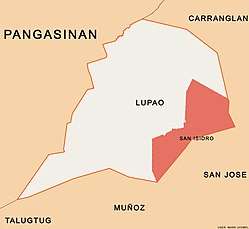 This map shows the map of Barangay San Isidro, Lupao, Nueva Ecija in the Philippines. | |
.svg.png) San Isidro | |
| Coordinates: 15°49′52.77″N 120°56′43.2528″E / 15.8313250°N 120.945348000°ECoordinates: 15°49′52.77″N 120°56′43.2528″E / 15.8313250°N 120.945348000°E | |
| Country | Philippines |
| Region | Central Luzon |
| Province | Nueva Ecija |
| City | Lupao |
| Established | 1938 |
| Government | |
| • Type | Barangay |
| • Barangay Captain | Reginald R. Espiritu |
| Area | |
| • Total | 21.8394 km2 (8.4322 sq mi) |
| Population (2015) | |
| • Total | 4,967[1] |
| Time zone | UTC+8 (PST) |
| Postal Code | 3122 |
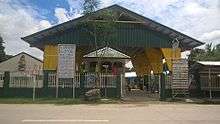
Barangay San Isidro is the largest barangay of Lupao, Nueva Ecija. It is also the most populous barangay outside the town proper and the second oldest barangay of Lupao next to Barangay Salvacion.[2]
Etymology
The word San Isidro is a Tagalog word translated from the Spanish St. Isidore the Farmer. The early residents devised the name because the primary source of income in the barangay is farming. They also named their barangay San Isidro which according to them, "the patron saint will give them prosperous amount of crops".[2]
History
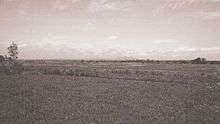
San Isidro as it is known today was originally called Macañawed derived from gawed, the local name of vines, the leaves of which are chewed by old folks with betel nuts, tobacco leaves and shell lime (apog). This plant grew abundantly in the place during the old times and provided sufficient supply to the customary nganga habit of their ancestors; hence this place was known as "Macañawed from the edible vine, gawed".[2]
As time goes by, people from different places lured the rich agricultural potential and vast area of the place, continuously migrated to Macañawed until there was a merger of inhabitant (Ilocanos, Tagalogs, Igorots, Kapampangans and others), Macañawed gradually became quickly populated and farming became the main source of livelihood because of its fertile soil.[2]
The inhabitants believed that to attain bountiful harvest and peaceful atmosphere, they need to have a patron saint. They chose San Isidro Labrador, the patron saint of farmers, whom they honor during their fiesta celebration. Gradually, the people began to call Macañawed as San Isidro.[2]
Location
San Isidro makes the southernmost part of Lupao. It borders barangays Balbalungao to the north, Mapangpang and Salvacion II to the west, San Jose City, Nueva Ecija to the south, and the mountain range of Caraballo and Carranglan, Nueva Ecija to the east. San Isidro is the largest barangay of Lupao. It is as almost as large as the eight smallest barangays of Lupao combined.
Demographics
San Isidro's inhabitants consists of Ilocanos, Tagalog, Pangasinans and Kapampangans. The latter two inhabitants makes less than 1% of the total population of the barangay. Tagalog is the primary language. Secondary language is Ilocano. Others speak English as it is taught in the schools.[1]
Government Officials
Barangay Captain[3]
- Marcial D. Managan
Kagawads[3]
- Marianito M. Gonzales
- Reginald R. Espiritu
- Romualdo Q. Farro Jr.
- Isidro N. Aguilar
- Yolanda F. Leal
- Luzviminda S. Isalmo
- Fernando R. Mendoza
Secretary[3]
- Jenny Rose B. Farro
Treasurer[3]
- Roxanne L. Gastardo
Gallery
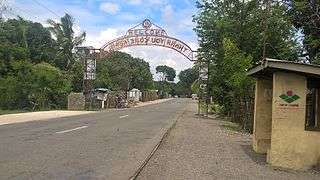 Arch of San Isidro, viewed from Balbalungao
Arch of San Isidro, viewed from Balbalungao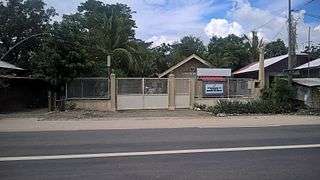 INC Church of San Isidro
INC Church of San Isidro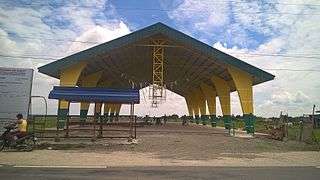 Newly Constructed barangay plaza
Newly Constructed barangay plaza RC Church of San Isidro
RC Church of San Isidro Barangay Cemetery
Barangay Cemetery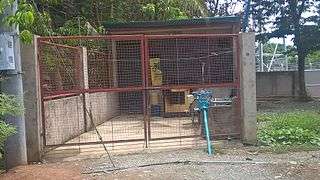 San Isidro Pumping Satation
San Isidro Pumping Satation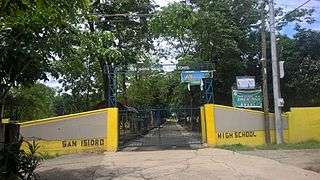 San Isidro National High School
San Isidro National High School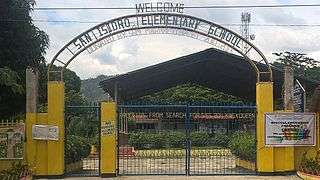 Entrance gate of San Isidro Elementary School.
Entrance gate of San Isidro Elementary School.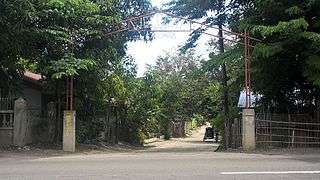 La Torma Street
La Torma Street
See also
References
- 1 2 "Population of Barangay San Isidro, Lupao". Philippine Statistics Authority. May 19, 2016. Retrieved December 11, 2017.
- 1 2 3 4 5 "San Isidro, Lupao, Nueva Ecija, Philippines - Universal Stewardship". www.zamboanga.com. Retrieved 2017-05-28.
- 1 2 3 4 "Barangay Elected Officials of Nueva Ecija Province for the term of 2010-2013 - Universal Stewardship". www.zamboanga.com. Retrieved 2017-05-28.